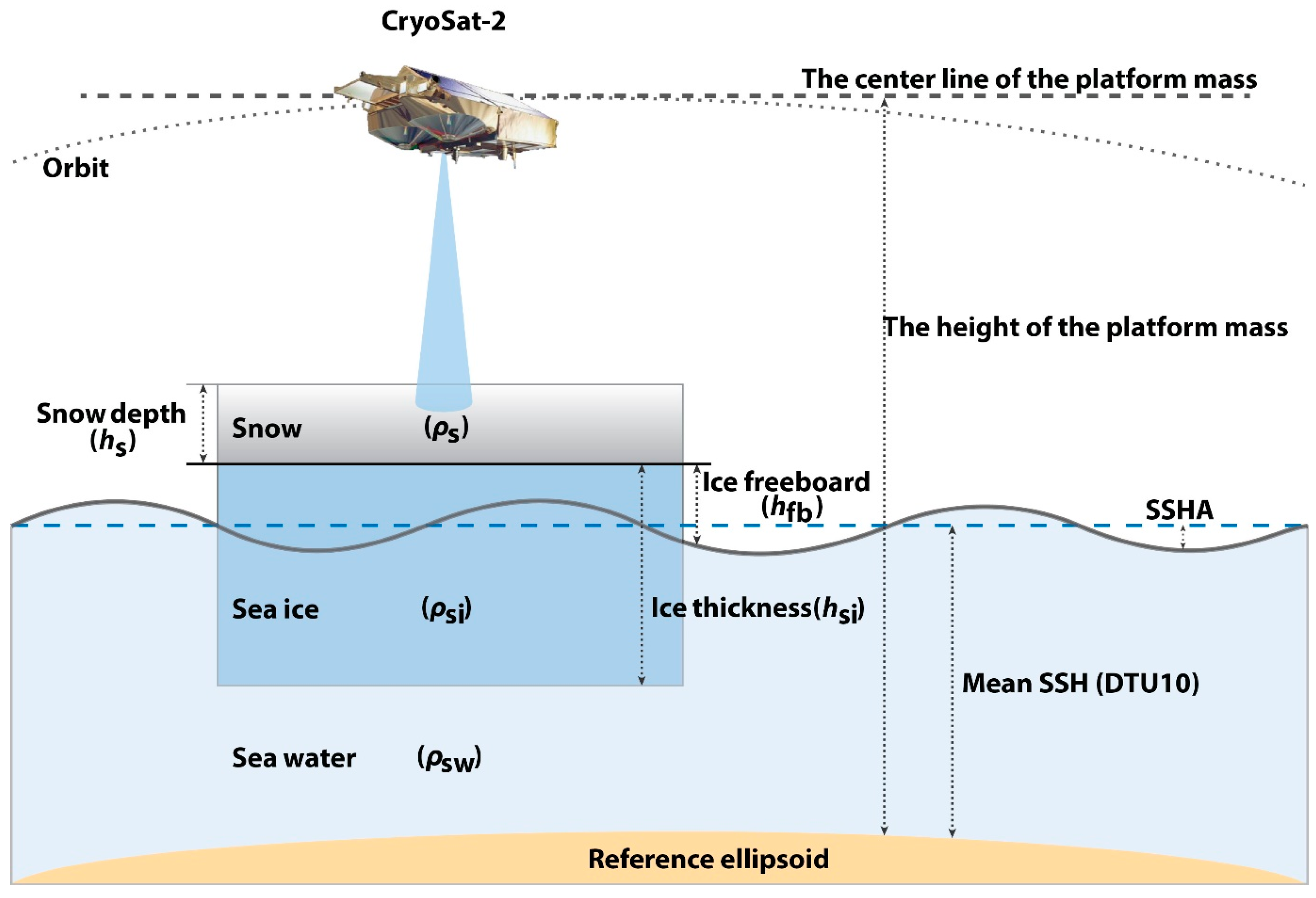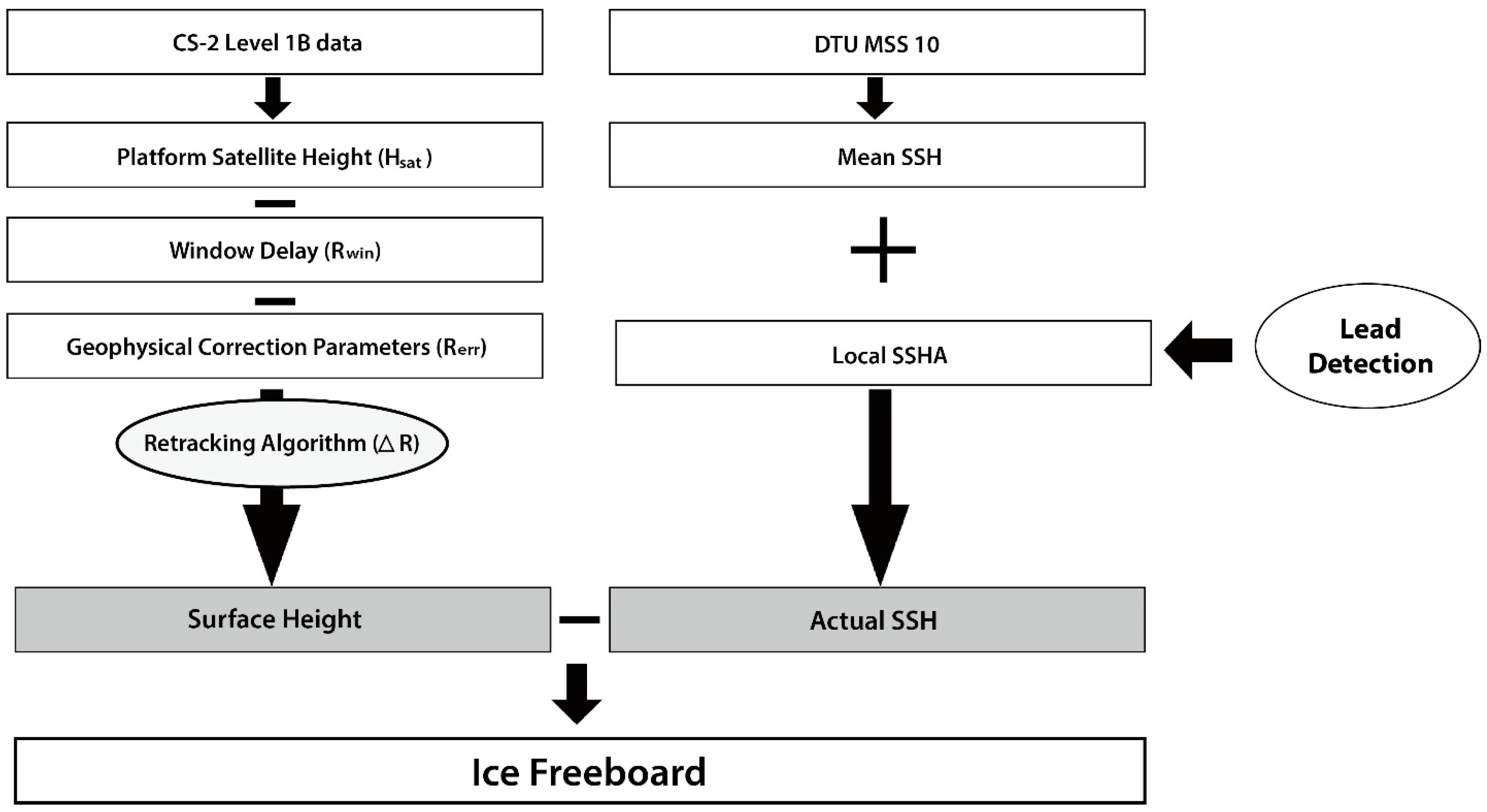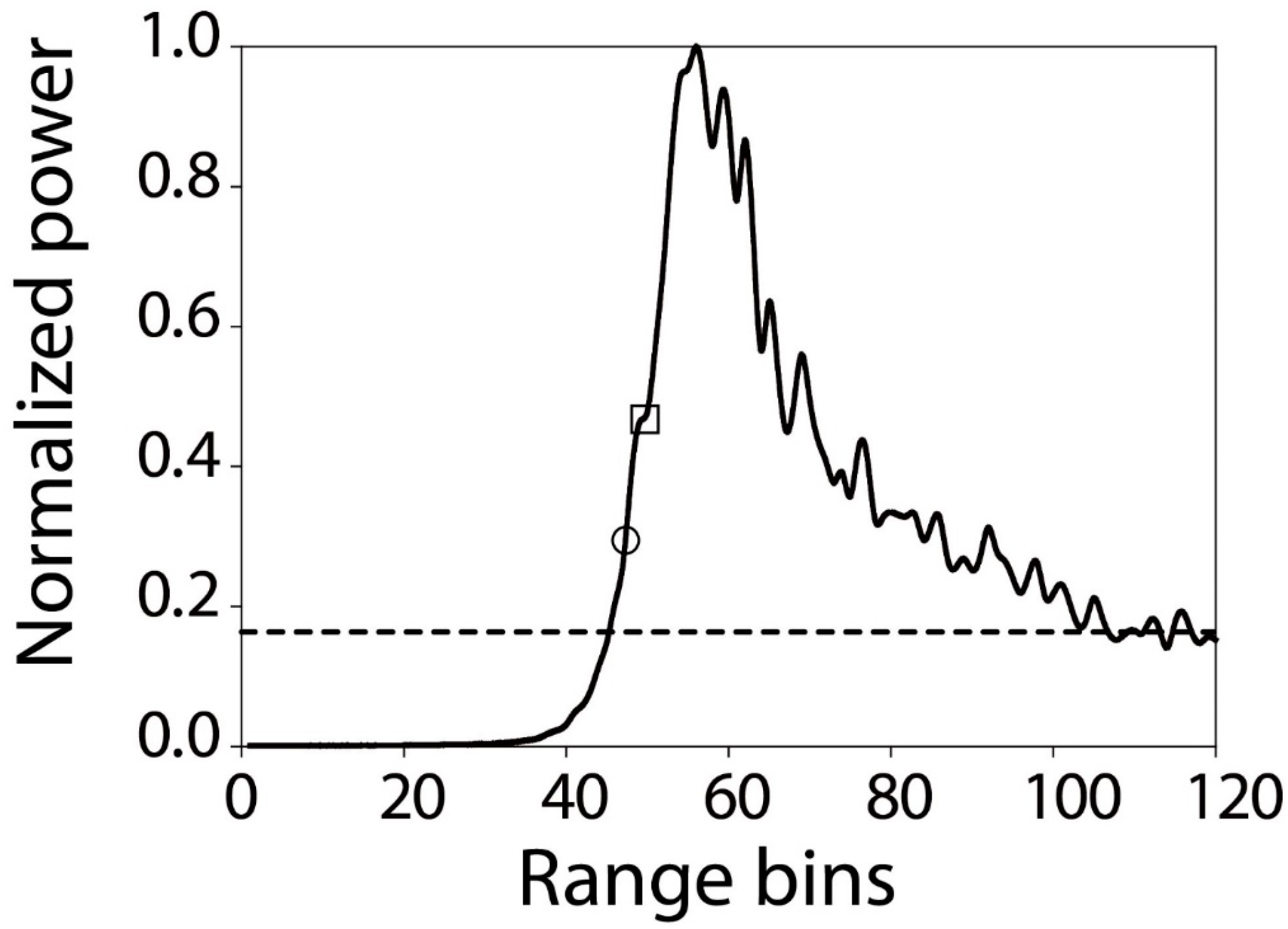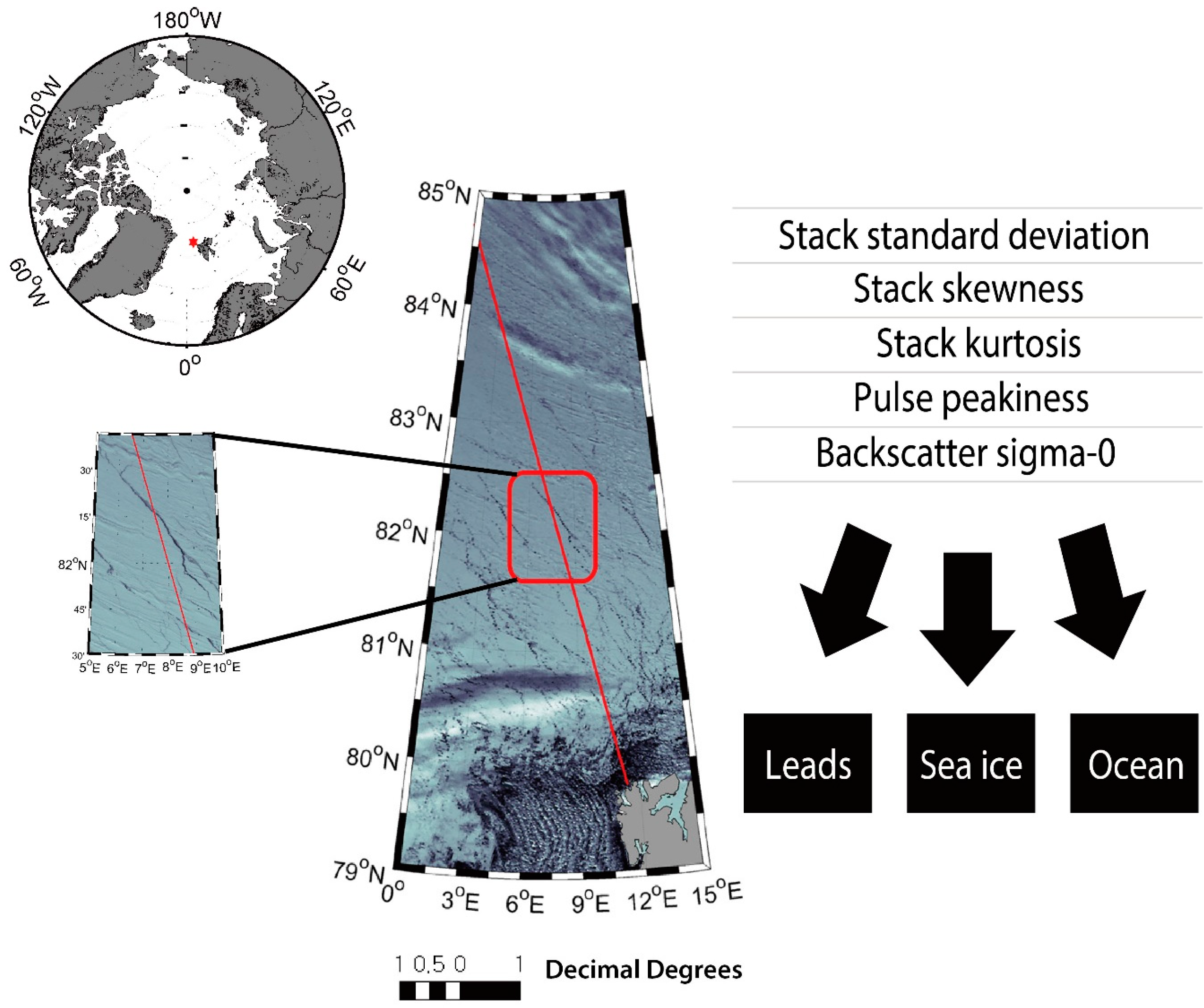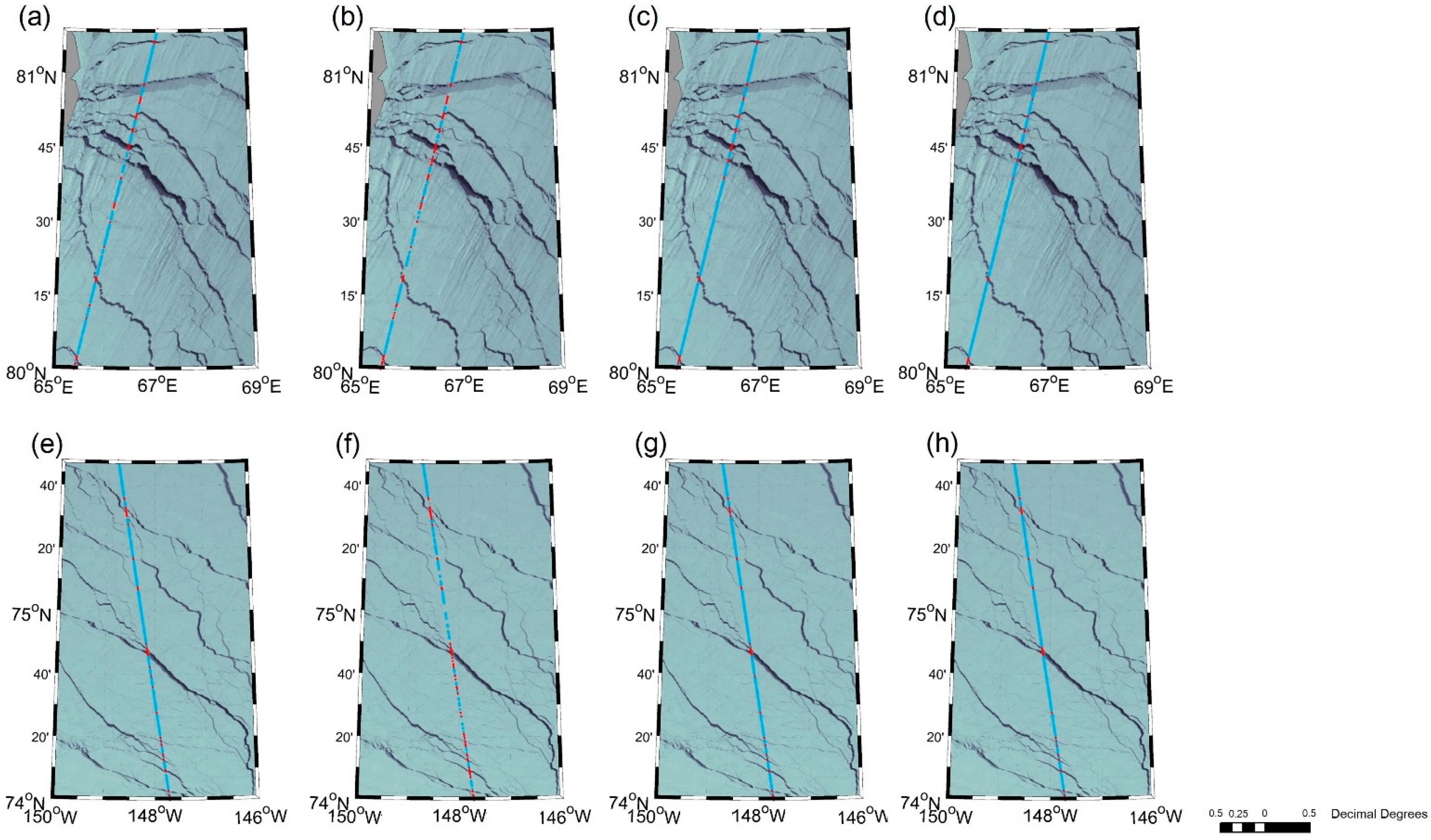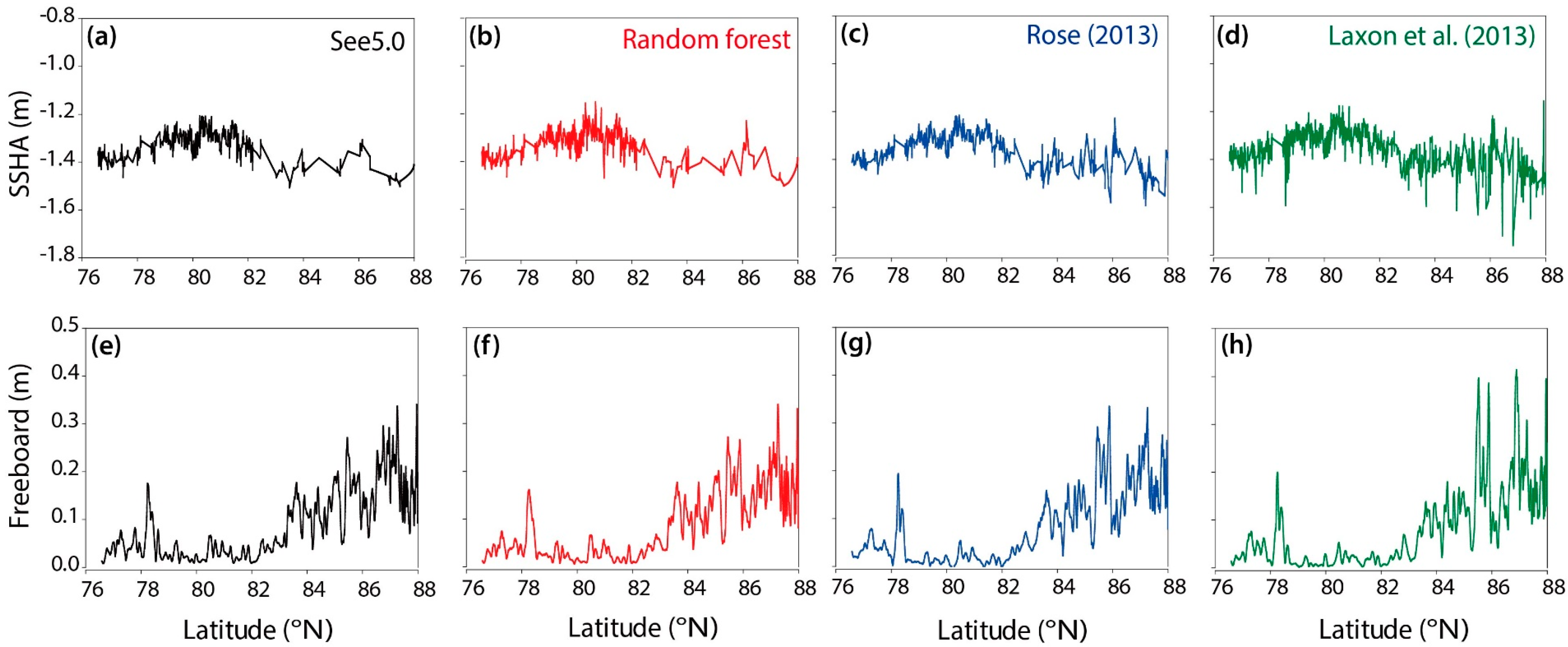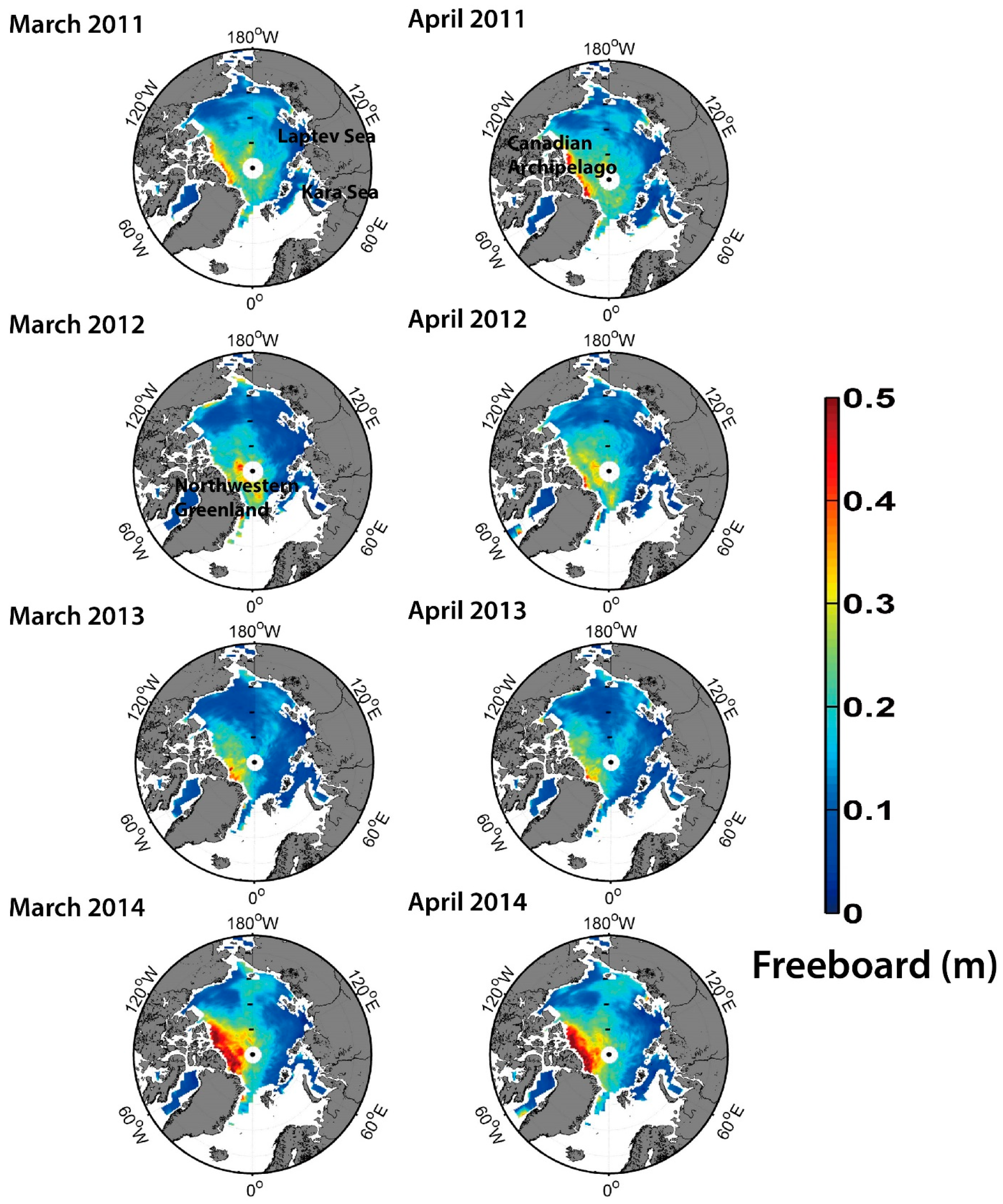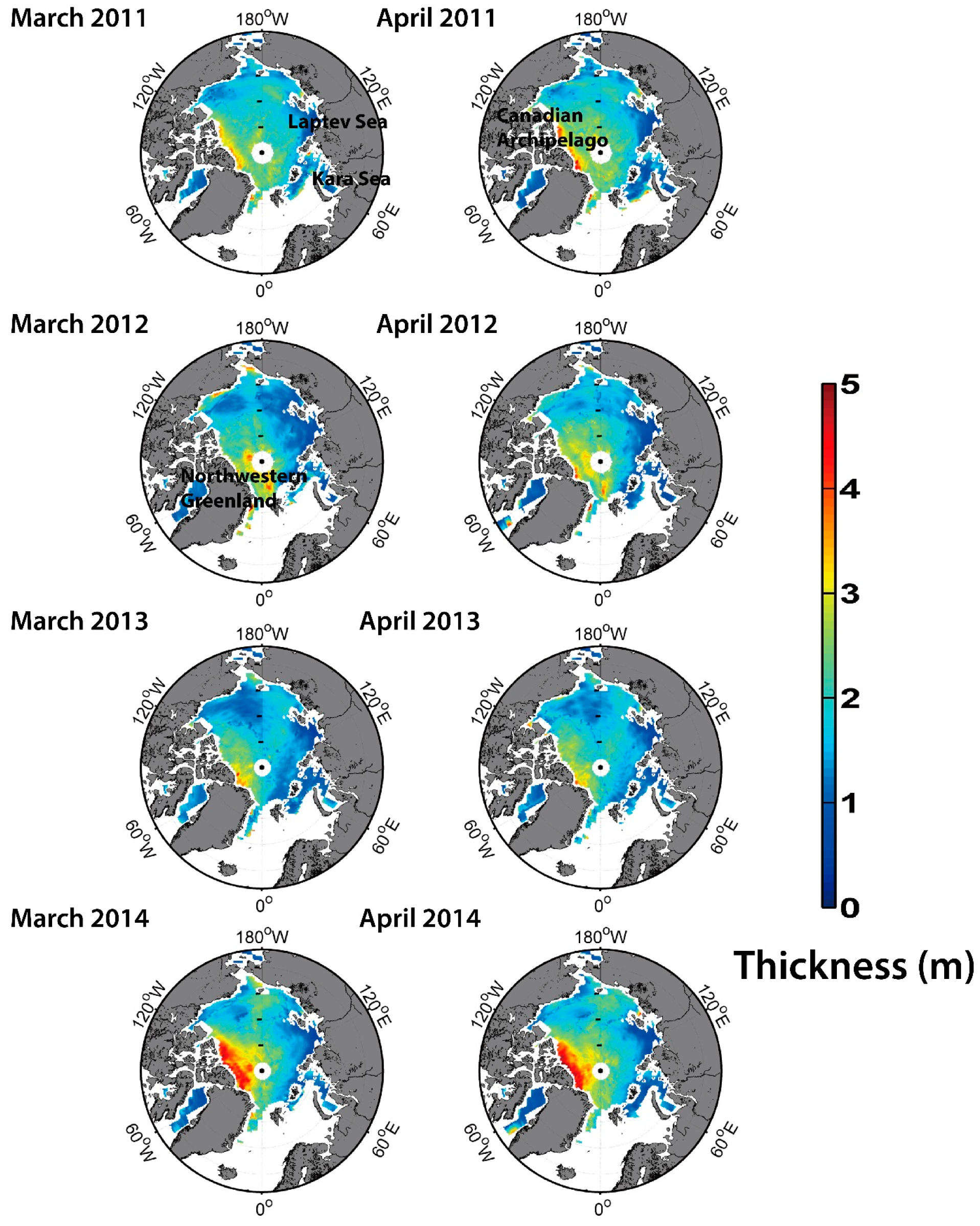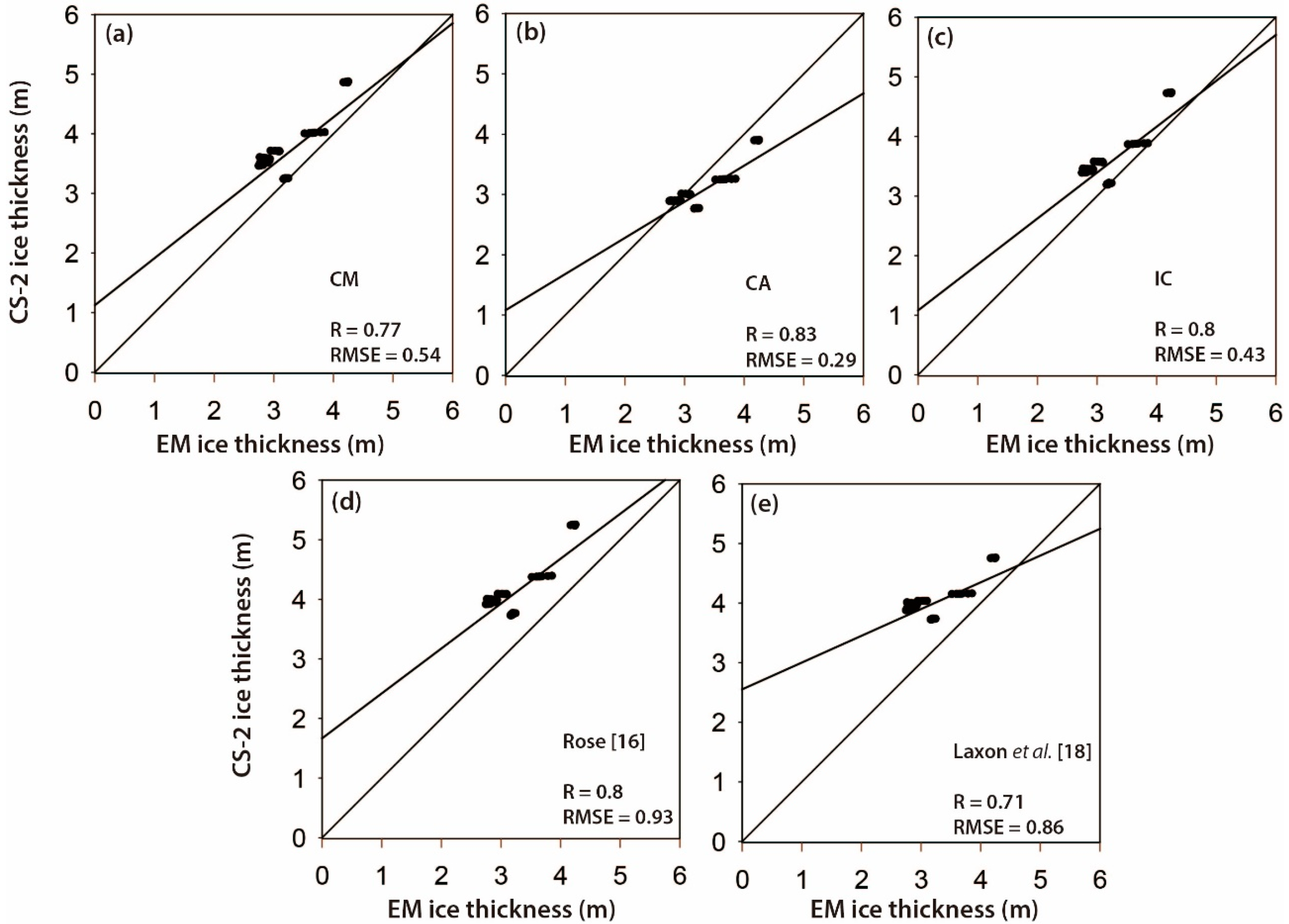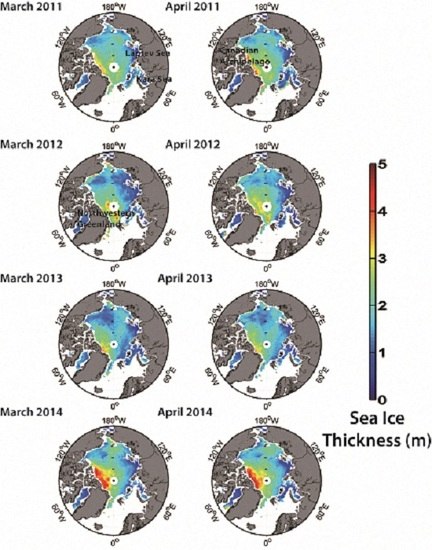3.1. Sea Ice Thickness Estimation
Estimation of the snow-covered Arctic sea ice thickness from CryoSat-2 measurements is based on the assumption of hydrostatic equilibrium [
18] (
Figure 1). If the sea ice freeboard (
) is accurately determined from altimeter measurements, the freeboard can be directly converted into sea ice thickness by Equation (1).
where
,
and
are the density of sea water, sea ice and snow, respectively, and
is the snow depth. Although the density parameters and snow depth should be observed concurrently with the altimeter measurements to best estimate the ice thickness, this is challenging due to the extreme weather conditions of the Arctic Ocean. Thus, studies have used typical values based on field measurements or numerical simulation. For example, Giles et al. [
32] and Wadhams [
10] used the density of sea water, sea ice and snow as 1023.8 ± 3, 915.1 ± 5 and 319.5 ± 3 kg/m
3, respectively, from field observations. In this study, 916.7 kg/m
3 and 882 kg/m
3 were used as the density of FYI and MYI, respectively, according to Alexandrov et al. [
33]. Snow depth simulated by the Warren 99 (hereafter W99) climatology model of Warren et al. [
34] has been widely applied. However, the original W99 data only capture the seasonal variability of snow depth. Kurtz and Farrell [
35] thus applied a modification to the snow depth data to reflect the significant decline in MYI over the last few years. Kurtz and Farrell [
35] suggested reducing the snow depth over FYI by 50%. In this study, FYI and MYI were discriminated by the ice type products derived by EUMETSAT OSI SAF, and we used the typical density and snow depth values derived by Kurtz and Farrell [
35].
As mentioned above, it is important to determine the sea ice freeboard from CryoSat-2 data in order to successfully estimate the ice thickness.
Figure 2 shows the procedure to determine the sea ice freeboard from CryoSat-2 L1B data. Initially, the surface height of the sea ice (i.e., the distance between the sea ice surface and the WGS84 ellipsoid) is estimated by Equation (2).
where
is the height of the satellite platform mass above the WGS84 ellipsoid.
is the window delay field, which means the distance between the mid-point of the range bin (i.e., 64th range bin in SAR mode and 256th range bin in SIN mode) of the waveform data and the satellite platform.
is a range correction term associated with the phase range due to geophysical properties, such as atmospheric effects. These variables are given in CryoSat-2 L1B data; detailed descriptions and processing methods of the variables are well explained in [
25].
is another correction term derived by various retracking methods [
36,
37,
38,
39]. The aim of these terms is to determine the range offset between the mid-point of the range bin and a realistic range point of the leading edge of sea ice. The retracking method used in this study is the Threshold First Maximum Retracker Algorithm (TFMRA) [
16,
18,
19].
Davis [
37] introduced the threshold retracking concept, which is useful for measuring the surface elevations of ice sheets or sea ice from radar altimeter data [
14,
19]. The retracking method determines the range point of the leading edge between the threshold level and the range point of the first maximum power peak. The threshold level (
) is determined by:
where
is the thermal noise of the CryoSat-2 system.
is the threshold value, the percentage of the maximum waveform amplitude above the thermal noise.
is the first maximum power of the waveform.
is the range bin of the first unaliased waveform.
is the power at the
-th range bin of the waveform. Finally, the retracking point (
) as the leading edge is estimated using the following equation.
where
is the first range point exceeding the threshold level. It is essential to detect the first peak in the range bin. Here, Rose [
16] indicated that the maximum power peak in the range bin may not be the first peak due to time delay effects of complicating factors, such as multiple scattering (i.e., in the surface) and volume scattering. Thus, the true range point (i.e., local maxima in the waveform) is detected by the peak detection algorithm, which identifies the range point using derivatives of the waveform signal [
19,
40]. Lastly,
, the retracking correction, is calculated using Equation (5).
where
is the retracking point and
is an on-board retracking point.
is a factor to convert from range bins to meters, which is 23.24 cm/bin for CryoSat-2.
Figure 3 shows an example of the peak detection algorithm. This figure illustrates that the range point of the first maximum power (the open square) was found prior to the maximum power peak, and the retracking point (the open circle) was determined between the range point of the first maximum power and the threshold level (the dotted line). While various threshold values
have been used in the literature, several studies have found that thresholds of 40% and 50% give the best result for determining the leading edge of the ice floe [
16,
40]. A threshold of 40% was used in the retracking method in this study as it was frequently used in the literature [
16,
19].
The next step removes the distance between the actual sea surface and the WGS84 ellipsoid from the surface height (η
sea_ice) in order to estimate the sea ice freeboard. In general, the actual Sea Surface Height (SSH) is estimated from the sum of the mean SSH and local Sea Surface Height Anomaly (SSHA). Mean SSH data were obtained from the Technical University of Denmark 10 (DTU10) product [
41]; local SSHA data were derived from the proposed lead detection method (
Section 3.2) that extracts leads from CryoSat-2 data. The SSHA observations were discontinuous because leads were detected at irregular intervals, thus linear interpolation and low-pass filtering were applied to make spatially-continuous SSHA. The local SSHA was used to remove the surface height from the mean SSH at the leads. Although many studies have tried to develop effective lead detection methods, it is still very difficult to accurately identify leads due to limited reference data, the irregular shape and size of leads and the characteristics leads share with ice or ocean. To overcome these challenges and correctly identify leads, this study proposed a novel lead detection method explained in
Section 3.2.
A correction to the sea ice thickness estimates from freeboard should be applied to account for the penetration of microwave radiation on snow and lower propagation speed in the snow pack. First of all, while typical microwave pulses do not penetrate the snow surface when the snow layer is wet during the melting season, it is well known that a K
u-band microwave penetrates the air/snow interface of dry and cold snow during the freezing season [
42,
43,
44]. This complexity makes it difficult to determine the optimum penetration depth to correct the sea ice freeboard. Nevertheless, Laxon et al. [
18] believed that microwaves fully penetrate the snow layer. Since the speed of microwave is typically lower in the snow pack [
45], it should also be corrected. However, given the uncertainty in these corrections, we did not apply the correction terms in order to enable consistent comparison with Laxon et al. [
18] and Ricker et al. [
19], who did not apply these corrections.
3.2. Machine Learning Algorithms for Lead Detection
In order to detect leads using machine learning approaches, reference samples were extracted using MODIS data. All 5-min MOD02QKM images above latitude 65°N in March and April 2011–2014 were downloaded. Cloud-free images were selected through visual interpretation. A total of 48 cloud-free March and April images were selected from MOD02QKM between 2011 and 2014 to clearly identify sea ice, leads and ocean based on visual interpretation of the images (
Figure 4). However, visual interpretation with MODIS is not always reliable because the leads in the MODIS images could refreeze, and new thin ice is formed. CryoSat-2 paths were geolocated over the MODIS images to extract five parameters (i.e., SSD, stack skewness, stack kurtosis, PP and backscatter sigma-0) for each class (i.e., lead, sea ice and ocean). The time difference between CryoSat-2 paths and MODIS images was set to within 30 min (12 min on average) to minimize sampling errors as sea ice sometimes moves fast. Since there were more leads found in the Arctic in April than March, the number of samples for April was larger than that for March. It should be noted that we could not extract samples all over the Arctic Region because spatiotemporal coincidence between CryoSat-2 and MODIS was limited during the given time period. Lead reference samples were not collected when the size of leads was smaller than 250 m considering the movement velocity of sea ice.
Since the characteristics of the sea ice surface have monthly and annual variations, three schemes were examined to develop machine learning models in this study. The first scheme was Classification of Monthly data (CM), which used the reference samples by month regardless of year and developed the machine learning models for both months (i.e., March and April). The second was Classification of Annual data (CA), which divided the samples by year and developed the models separately for each year (i.e., 2011, 2012, 2013 and 2014). Individual Classifications (IC) used all reference data to develop the machine learning models to consider the tradeoff between transferability and accuracy.
In order to detect leads, we used two rule-based machine learning approaches: decision trees and random forest. Decision trees are one of the most widely-used machine learning algorithms for inductive inference [
46,
47,
48]. To implement decision trees, See 5.0 was used. See 5.0 recursively splits training data into subdivisions based on a set of attributes defined at each node in a tree [
49]. An attribute is selected at each node and two branches that descend from that node use a value of the attribute as a threshold. Selecting an attribute (i.e., STD, stack skewness, stack kurtosis, PP or backscatter sigma-0 in this study) at each node is crucial for successful classification. In general, statistical properties, such as information gain or the Gini index, are used to choose an appropriate attribute in decision trees. See 5.0 uses information gain to select which candidate attribute is used at each node. See 5.0 has been widely used for various remote sensing applications, including land cover/land use classification [
50,
51,
52], climate region delineation [
53], vegetation species mapping [
54,
55], ice mapping [
56] and change detection [
57,
58]. Using a See 5.0 decision tree has some advantages. First, it provides a non-parametric classification, and thus, it does not require any assumptions in terms of the distribution of training data. See 5.0 can also handle non-linear relationships between classes and features, even with missing values. In addition, See 5.0 transforms a decision tree into a series of production rulesets, which makes it easier and more straightforward for human interpretation of the results.
Random forest uses an ensemble approach that combines a boosting sampling strategy and Classification And Regression Trees (CART) [
59] to improve the weaknesses of a single CART such as overfitting and sensitivity to training data configuration. CART uses a Gini index to measure impurity from training samples, while See 5.0 uses the concept of entropy. The Gini index is defined as shown in Equation (6)
where
c is the number of classes and
is the proportion of S belonging to class
i. The Gini gain is used to identify the most appropriate attribute at each node. Since it is similar to the information gain, it is defined by replacing the entropy with the Gini index in the Equation (6). However, a single CART is often unstable and tends to overfit training data. Bagging can overcome such weaknesses by creating
n independent trees and help minimize errors that can be caused from unstable classifiers [
60]. Random forest produces numerous independent trees through two bagging-based randomization processes: (1) using a random subset of training data for each tree; and (2) using a random subset of input variables at each node of a tree. Breiman [
58] pointed out that it is not necessary to use a separate dataset for model validation, as random forest uses out-of-bag data (i.e., training data that are not used) for internal cross-validation. A majority voting strategy is used to combine the results from multiple classifiers to determine the final class for a given sample. In addition, random forest provides the relative importance of a variable using out-of-bag data when the variable is permuted. Because of these strengths, random forest has proven robust in various remote sensing applications [
61,
62,
63,
64,
65,
66,
67,
68].
